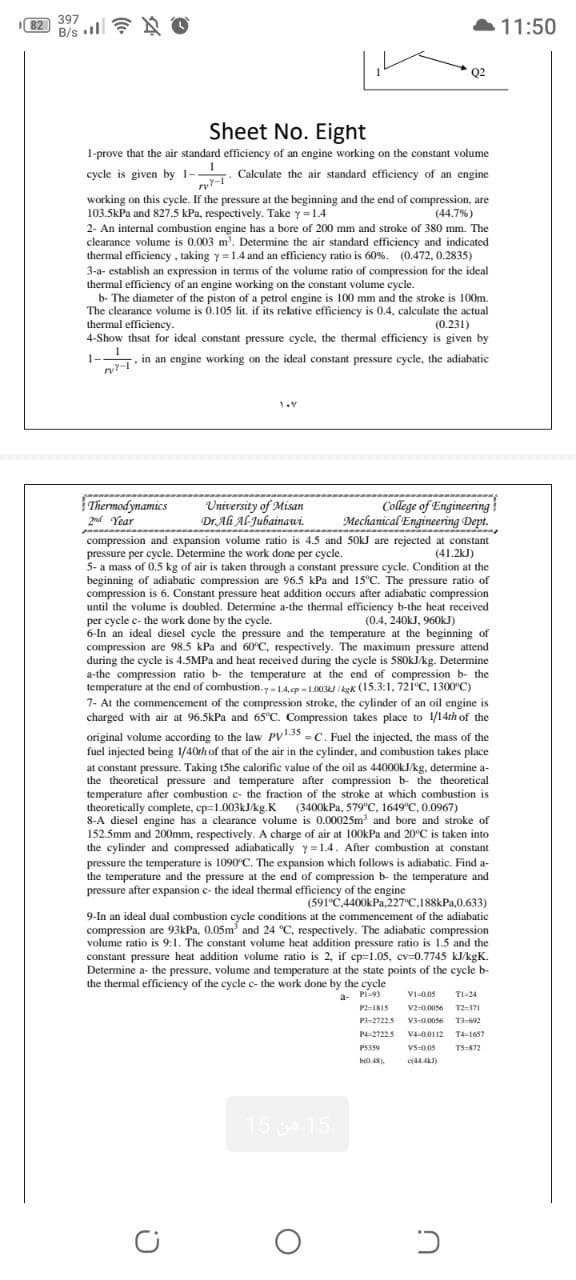1-prove that the air standard efficiency of an engine working on the constant volume cycle is given by 1-- Calculate the air standard efficiency of an engine working on this cycle. If the pressure at the beginning and the end of compression, are 103.5kPa and 827.5 kPa, respectively. Take y =1.4 (44.7%)
1-prove that the air standard efficiency of an engine working on the constant volume cycle is given by 1-- Calculate the air standard efficiency of an engine working on this cycle. If the pressure at the beginning and the end of compression, are 103.5kPa and 827.5 kPa, respectively. Take y =1.4 (44.7%)
Elements Of Electromagnetics
7th Edition
ISBN:9780190698614
Author:Sadiku, Matthew N. O.
Publisher:Sadiku, Matthew N. O.
ChapterMA: Math Assessment
Section: Chapter Questions
Problem 1.1MA
Related questions
Question

Transcribed Image Text:397
82
B/s O
11:50
Q2
Sheet No. Eight
1-prove that the air standard efficiency of an engine working on the constant volume
cycle is given by 1- Calculate the air standard efficiency of an engine
working on this cycle. If the pressure at the beginning and the end of compression, are
103.5kPa and 827.5 kPa, respectively. Take y =1.4
(44.7%)
2- An internal combustion engine has a bore of 200 mm and stroke of 380 mm. The
clearance volume is 0.003 m'. Determine the air standard efficiency and indicated
thermal efficiency , taking y=1.4 and an efficiency ratio is 60%. (0.472, 0.2835)
3-a- establish an expression in terms of the volume ratio of compression for the ideal
thermal efficiency of an engine working on the constant volume cycle.
b- The diameter of the piston of a petrol engine is 100 mm and the stroke is 100m.
The clearance volume is 0.105 lit. if its relative efficiency is 0.4, calculate the actual
thermal efficiency.
4-Show thsat for ideal constant pressure cycle, the thermal efficiency is given by
(0.231)
. in an engine working on the ideal constant pressure cycle, the adiabatic
1-
Thermodynamics
2nd Year
University of Misan
Dr. Ali Al-Jubainawi.
College of Engineering
Mechanical Engineering Dept.
compression and expansion volume ratio is 4.5 and 50kJ are rejected at constant
pressure per cycle. Determine the work done per cycle.
5- a mass of 0.5 kg of air is taken through a constant pressure cycle. Condition at the
beginning of adiabatic compression are 96.5 kPa and 15°C. The pressure ratio of
compression is 6. Constant pressure heat addition occurs after adiabatic compression
until the volume is doubled. Determine a-the thermal efficiency b-the heat received
per cycle c- the work done by the cycle.
6-In an ideal diesel cycle the pressure and the temperature at the beginning of
compression are 98.5 kPa and 60°C, respectively. The maximum pressure attend
during the cycle is 4.5MPA and heat received during the cycle is 580KJ/kg. Determine
a-the compression ratio b- the temperature at the end of compression b- the
temperature at the end of combustion.y-14.p - 1.003J I kgk (15.3:1, 721°C, 1300°C)
7- At the commencement of the compression stroke, the cylinder of an oil engine is
charged with air at 96.5kPa and 65°C. Compression takes place to 1/14th of the
(41.2kJ)
(0.4, 240KJ, 960kJ)
original volume according to the law PV35 -C. Fuel the injected, the mass of the
fuel injected being 1/40th of that of the air in the cylinder, and combustion takes place
at constant pressure. Taking t5he calorific value of the oil as 44000kJ/kg, determine a-
the theoretical pressure and temperature after compression b- the theoretical
temperature after combustion c- the fraction of the stroke at which combustion is
theoretically complete, ep-1.003KJ/kg.K (3400kPa, 579°C, 1649'c, 0.0967)
8-A diesel engine has a clearance volume is 0.00025m and bore and stroke of
152.5mm and 200mm, respectively. A charge of air at 100kPa and 20°C is taken into
the cylinder and compressed adiabatically y=1.4. After combustion at constant
pressure the temperature is 1090°C. The expansion which follows is adiabatic. Find a-
the temperature and the pressure at the end of compression b- the temperature and
pressure after expansion c- the ideal thermal efficiency of the engine
(591°C.4400kPa,227°C,188kPa,0.633)
9-In an ideal dual combustion cycle conditions at the commencement of the adiabatic
compression are 93kPa, 0.05m and 24 °C. respectively. The adiabatic compression
volume ratio is 9:1. The constant volume heat addition pressure ratio is 1.5 and the
constant pressure heat addition volume ratio is 2, if cp=1.05, cv=0.7745 kJ/kgK.
Determine a- the pressure, volume and temperature at the state points of the cycle b-
the thermal efficiency of the cycle c- the work done by the cycle
a- Pi-93
VI-0.05
TI-24
P2-INIS
V2-0.0056 T2371
P3-27225
V3-0.0056
P4-27225
V4-0.0112 T4-1657
PS359
VS-005
TS-K72
15 15
Expert Solution
This question has been solved!
Explore an expertly crafted, step-by-step solution for a thorough understanding of key concepts.
Step by step
Solved in 3 steps with 1 images

Knowledge Booster
Learn more about
Need a deep-dive on the concept behind this application? Look no further. Learn more about this topic, mechanical-engineering and related others by exploring similar questions and additional content below.Recommended textbooks for you

Elements Of Electromagnetics
Mechanical Engineering
ISBN:
9780190698614
Author:
Sadiku, Matthew N. O.
Publisher:
Oxford University Press

Mechanics of Materials (10th Edition)
Mechanical Engineering
ISBN:
9780134319650
Author:
Russell C. Hibbeler
Publisher:
PEARSON

Thermodynamics: An Engineering Approach
Mechanical Engineering
ISBN:
9781259822674
Author:
Yunus A. Cengel Dr., Michael A. Boles
Publisher:
McGraw-Hill Education

Elements Of Electromagnetics
Mechanical Engineering
ISBN:
9780190698614
Author:
Sadiku, Matthew N. O.
Publisher:
Oxford University Press

Mechanics of Materials (10th Edition)
Mechanical Engineering
ISBN:
9780134319650
Author:
Russell C. Hibbeler
Publisher:
PEARSON

Thermodynamics: An Engineering Approach
Mechanical Engineering
ISBN:
9781259822674
Author:
Yunus A. Cengel Dr., Michael A. Boles
Publisher:
McGraw-Hill Education

Control Systems Engineering
Mechanical Engineering
ISBN:
9781118170519
Author:
Norman S. Nise
Publisher:
WILEY

Mechanics of Materials (MindTap Course List)
Mechanical Engineering
ISBN:
9781337093347
Author:
Barry J. Goodno, James M. Gere
Publisher:
Cengage Learning

Engineering Mechanics: Statics
Mechanical Engineering
ISBN:
9781118807330
Author:
James L. Meriam, L. G. Kraige, J. N. Bolton
Publisher:
WILEY